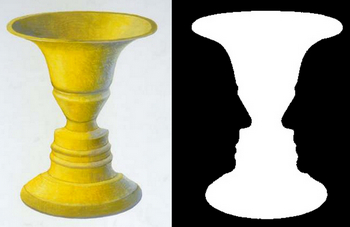Positive and Negative Space
This activity belongs to the GeoGebra book Voronoi Paintings.
In pictorial composition, positive space refers to the areas occupied by focal zones, while the surrounding area is called negative space. In Figure 4, the positive space is the figure of the man sitting and working, whose silhouette we have cut out, and the negative space is the vegetation surrounding him.
On some very special occasions, positive and negative spaces can be reversed. One of the most well-known examples is Rubin’s vase (see [10, 12], Figure 6). Initially, the positive space is the vase. However, the negative space, highlighted as a black silhouette in the image on the right, takes on its own prominence as we observe and recognize its profile.
In pictorial composition, the distribution of focal zones that make up the positive space is fundamental. Some of these distributions, due to their simplicity, are recurrent, appearing repeatedly throughout history in different artistic movements. For example, common distributions include mirror (axial symmetry), circular, radial, diagonal, triangular, tabular (matrix-like), etc. Our purpose is not to analyze a painting from this perspective, as we will often consider different focal zones as a single one, focusing only on their silhouettes, as explained below.
Authors of the activity: Rafael Losada & Tomás Recio.
